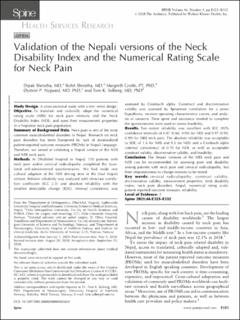| dc.contributor.author | Shrestha, Dipak | |
| dc.contributor.author | Shrestha, Rohit | |
| dc.contributor.author | Grotle, Margreth | |
| dc.contributor.author | Nygaard, Øystein Petter | |
| dc.contributor.author | Solberg, Tore | |
| dc.date.accessioned | 2021-03-29T10:50:06Z | |
| dc.date.available | 2021-03-29T10:50:06Z | |
| dc.date.created | 2021-02-08T00:20:06Z | |
| dc.date.issued | 2020 | |
| dc.identifier.citation | Spine. 2020, 46 (5), E325-E332. | en_US |
| dc.identifier.issn | 0362-2436 | |
| dc.identifier.uri | https://hdl.handle.net/11250/2735935 | |
| dc.description.abstract | Study Design. A cross-sectional study with a test–retest design. Objective. To translate and culturally adapt the numerical rating scale (NRS) for neck pain intensity and the Neck Disability Index (NDI), and asses their measurement properties in a Nepalese neck pain population. Summary of Background Data. Neck pain is one of the most common musculoskeletal disorders in Nepal. Research on neck pain disorders has been hampered by lack of standardized patient-reported outcome measures (PROMs) in Nepali language. Therefore, we aimed at validating a Nepali version of the NDI and NRS neck pain. Methods. At Dhulikhel hospital in Nepal, 150 patients with neck pain and/or cervical radiculopathy completed the translated self-administered questionnaires. We had made one cultural adaption of the NDI driving item in the final Nepali version. Relative reliability was analyzed with intraclass correlation coefficient (ICC 2.1) and absolute reliability with the smallest detectable change (SDC). Internal consistency was assessed by Cronbach alpha. Construct and discriminative validity was assessed by Spearman correlation for a priori hypotheses, receiver-operating characteristics curves, and analysis of variance. Time spent and assistance needed to complete the questionnaires were used to assess feasibility. Results. Test–restest reliability was excellent with ICC (95% confidence intervals) of 0.87 (0.66, 0.94) for NDI and 0.97 (0.94, 0.99) for NRS neck pain. The absolute reliability was acceptable (a SDC of 1.6 for NRS and 9.3 for NDI) and a Cronbach alpha (internal consistency) of 0.70 for NDI, as well as acceptable construct validity, discriminative validity, and feasibility. Conclusion. The Nepali versions of the NRS neck pain and NDI can be recommended for assessing pain and disability among patients with neck pain and cervical radiculopathy, but their responsiveness to change remains to be tested. Key words: cervical radiculopathy, construct validity, discriminative validity, measurement properties, neck disability index, neck pain disorders, Nepal, numerical rating scale, patient reported outcome measure, reliability. | en_US |
| dc.language.iso | eng | en_US |
| dc.publisher | Lippincott, Williams & Wilkins | en_US |
| dc.rights | Attribution-NonCommercial-NoDerivatives 4.0 Internasjonal | * |
| dc.rights.uri | http://creativecommons.org/licenses/by-nc-nd/4.0/deed.no | * |
| dc.title | Validation of the Nepali versions of the Neck Disability Index and the Numerical Rating Scale for Neck Pain | en_US |
| dc.type | Peer reviewed | en_US |
| dc.type | Journal article | en_US |
| dc.description.version | publishedVersion | en_US |
| dc.source.pagenumber | E325-E332 | en_US |
| dc.source.volume | 46 | en_US |
| dc.source.journal | Spine | en_US |
| dc.source.issue | 5 | en_US |
| dc.identifier.doi | 10.1097/brs.0000000000003810 | |
| dc.identifier.cristin | 1887487 | |
| dc.description.localcode | Copyright © 2020 The Author(s). This is an open-access article distributed under the terms of the Creative Commons Attribution-Non Commercial-No Derivatives License 4.0 (CCBYNC-ND), where it is permissible to download and share the work provided it is properly cited. The work cannot be changed in any way or used commercially without permission from the journal. | en_US |
| cristin.ispublished | true | |
| cristin.fulltext | original | |
| cristin.qualitycode | 2 | |

